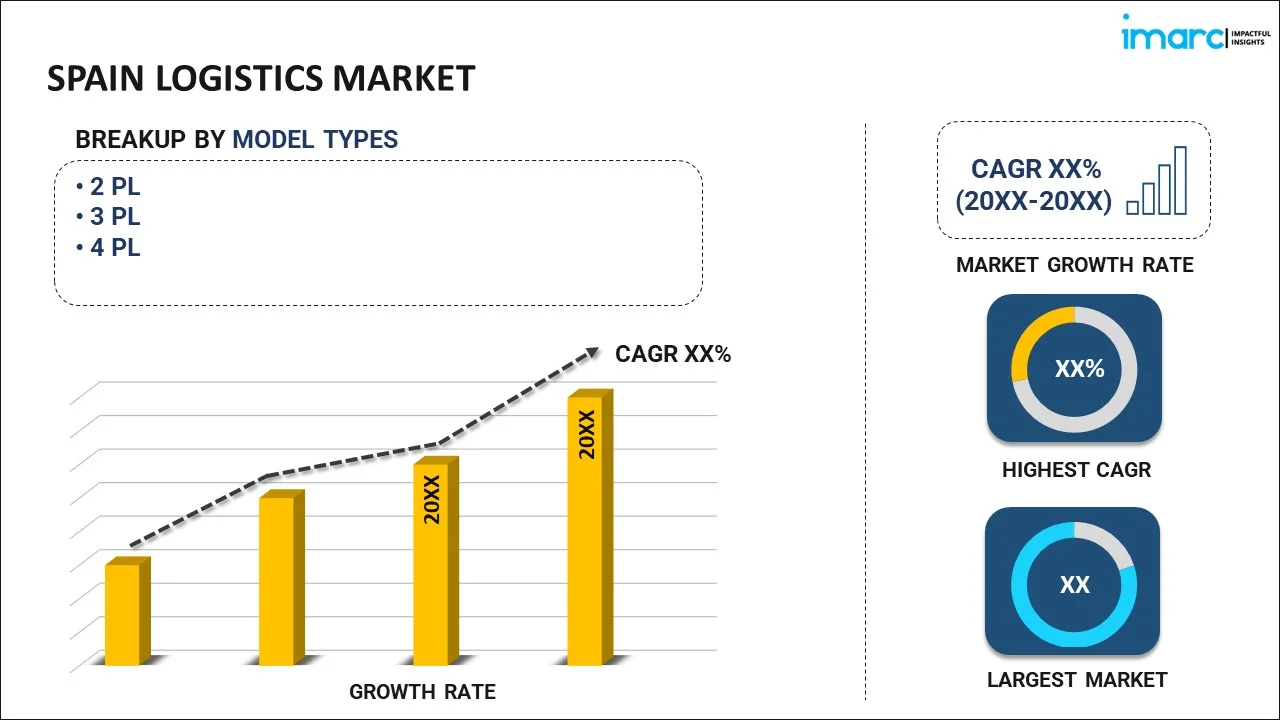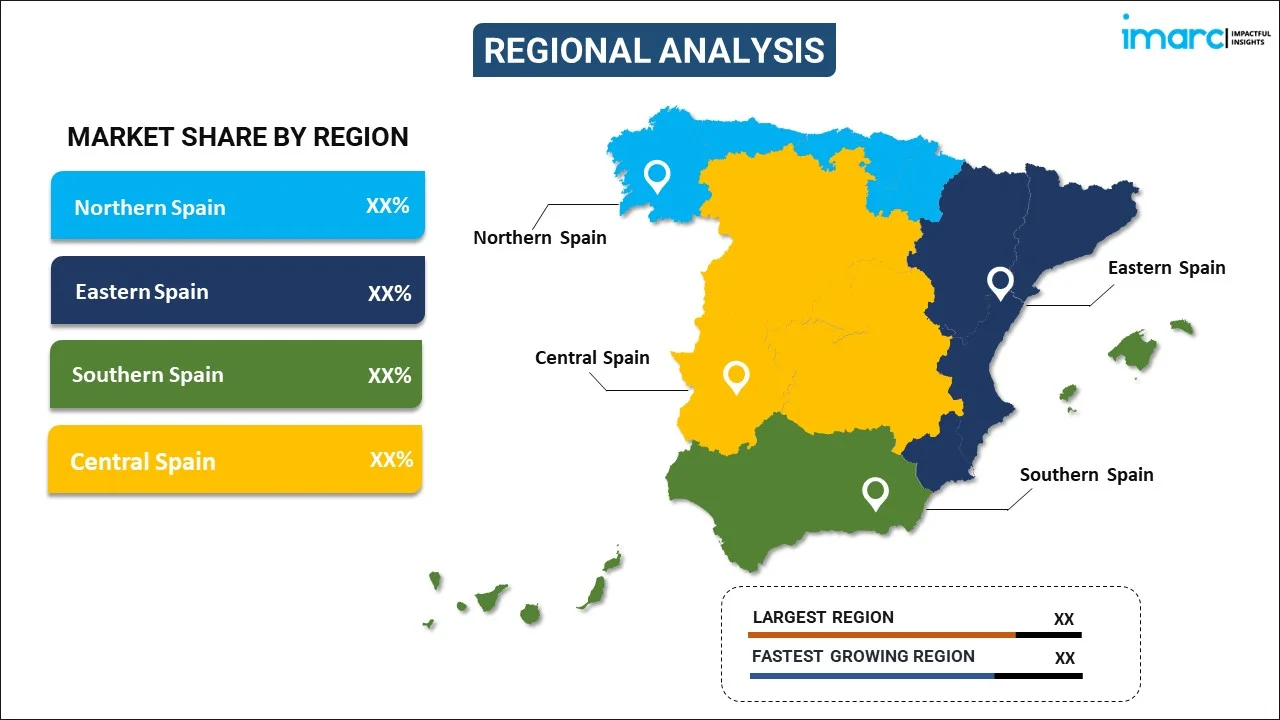
Spain Logistics Market Report by Model Type (2 PL, 3 PL, 4 PL), Transportation Mode (Roadways, Seaways, Railways, Airways), End Use (Manufacturing, Consumer Goods, Retail, Food and Beverages, IT Hardware, Healthcare, Chemicals, Construction, Automotive, Telecom, Oil and Gas, and Others), and Region 2025-2033
Spain Logistics Market Overview:
The Spain logistics market size reached USD 70.1 Billion in 2024. Looking forward, IMARC Group expects the market to reach USD 95.2 Billion by 2033, exhibiting a growth rate (CAGR) of 3.46% during 2025-2033. Increasing e-commerce users, growing demand for warehousing, urban logistics, ongoing advancements in technology, and rising emphasis on sustainability initiatives, is expanding the growth of the market.
|
Report Attribute
|
Key Statistics
|
|---|---|
|
Base Year
|
2024 |
|
Forecast Years
|
2025-2033 |
|
Historical Years
|
2019-2024
|
| Market Size in 2024 | USD 70.1 Billion |
| Market Forecast in 2033 | USD 95.2 Billion |
| Market Growth Rate (2025-2033) | 3.46% |
Spain Logistics Market Trends:
Increasing E-commerce Users
Increase in e-commerce users means the number of parcels being shipped and delivered across the country are growing continuously. This increase in demand allows logistics firms to scale up their operations and infrastructure to accommodate the extra workload. Furthermore, to satisfy the needs of e-commerce users for fast and transparent delivery, more technology solutions are being employed by logistics providers. This includes route optimization tools, real-time tracking technologies, and warehouse automation solutions to enhance efficiency and customer satisfaction. Apart from this, e-commerce users also tend to demand hassle-free returns processes, which further complicates the logistics process. Returns management processes must be established to deal with returned products and to ensure exchanges or refunds are processed efficiently. Companies in the logistics industry are coming up with ways to address the issue of reverse logistics effectively and reduce the costs associated with returns. Additionally, e-commerce users have high expectations when it comes to delivery speed, flexibility, and transparency. They expect to receive timely updates on the status of their orders and have the flexibility to choose delivery options that suit their preferences. As per the International Trade Administration report, the number of e-commerce users in Spain are expected to grow by 25% and reach 37 million by 2025.
Warehousing Demand
Inventory management is crucial for online and physical stores. Warehousing centers are core in the holding, sorting, and handling products to support order processing. Logistics firms are also investing in modern warehouses equipped with advanced technologies like automation and robotics to utilize space more efficiently. In addition, warehousing is an integral component of the supply chain since it is the center for receiving, storing, and distributing products. Key players are positioning warehouses in major transportation routes and near major population centers to minimize transportation costs, reduce delivery time and increase supply chain effectiveness. This strategic placement helps to optimize inventory flow and meet individual demand effectively. For instance, in 2024, Yusen Logistics (UK), a leading provider of logistics solutions, and SEGRO, the leading owner, manager and developer of modern warehouses and industrial property signed a contract for a new warehouse project in Northampton. This partnership sets a new logistics industry benchmark and further emphasizes Yusen Logistics’ commitment to providing sustainable logistics services by 2030.
Spain Logistics Market News:
- May 16, 2024: CEVA Logistics, ENGIE, and SANEF partners in the European lean transport network (ECTN) alliance launched the proof of concept of the low-carbon, long-distance road transport in Europe.
- June 27, 2023: Transfesa Logistics signed an agreement to join Forética, the leading organization in sustainability and corporate social responsibility in Spain to strengthen its commitment to sustainable development and to reinforce the network of partners in a sector that is key to the reduction of carbon dioxide (CO2) output of transport.
Spain Logistics Market Segmentation:
IMARC Group provides an analysis of the key trends in each segment of the market, along with forecasts at the country level for 2025-2033. Our report has categorized the market based on model type, transportation mode, and end use.
Model Type Insights:

- 2 PL
- 3 PL
- 4 PL
The report has provided a detailed breakup and analysis of the market based on the model type. This includes 2 PL, 3 PL, and 4 PL.
Transportation Mode Insights:
- Roadways
- Seaways
- Railways
- Airways
A detailed breakup and analysis of the market based on the transportation mode have also been provided in the report. This includes roadways, seaways, railways, and airways.
End Use Insights:
- Manufacturing
- Consumer Goods
- Retail
- Food and Beverages
- IT Hardware
- Healthcare
- Chemicals
- Construction
- Automotive
- Telecom
- Oil and Gas
- Others
The report has provided a detailed breakup and analysis of the market based on the end use. This includes manufacturing, consumer goods, retail, food and beverages, IT hardware, healthcare, chemicals, construction, automotive, telecom, oil and gas, and others.
Regional Insights:

- Northern Spain
- Eastern Spain
- Southern Spain
- Central Spain
The report has also provided a comprehensive analysis of all the major regional markets, which include Northern Spain, Eastern Spain, Southern Spain, and Central Spain.
Competitive Landscape:
The market research report has also provided a comprehensive analysis of the competitive landscape. Competitive analysis such as market structure, key player positioning, top winning strategies, competitive dashboard, and company evaluation quadrant has been covered in the report. Also, detailed profiles of all major companies have been provided.
Spain Logistics Market Report Coverage:
| Report Features | Details |
|---|---|
| Base Year of the Analysis | 2024 |
| Historical Period | 2019-2024 |
| Forecast Period | 2025-2033 |
| Units | Billion USD |
| Scope of the Report | Exploration of Historical Trends and Market Outlook, Industry Catalysts and Challenges, Segment-Wise Historical and Future Market Assessment:
|
| Model Types Covered | 2 PL, 3 PL, 4 PL |
| Transportation Modes Covered | Roadways, Seaways, Railways, Airways |
| End Uses Covered | Manufacturing, Consumer Goods, Retail, Food and Beverages, IT Hardware, Healthcare, Chemicals, Construction, Automotive, Telecom, Oil and Gas, Others |
| Regions Covered | Northern Spain, Eastern Spain, Southern Spain, Central Spain |
| Customization Scope | 10% Free Customization |
| Post-Sale Analyst Support | 10-12 Weeks |
| Delivery Format | PDF and Excel through Email (We can also provide the editable version of the report in PPT/Word format on special request) |
Key Questions Answered in This Report:
- How has the Spain logistics market performed so far and how will it perform in the coming years?
- What has been the impact of COVID-19 on the Spain logistics market?
- What is the breakup of the Spain logistics market on the basis of model type?
- What is the breakup of the Spain logistics market on the basis of transportation mode?
- What is the breakup of the Spain logistics market on the basis of end use?
- What are the various stages in the value chain of the Spain logistics market?
- What are the key driving factors and challenges in the Spain logistics?
- What is the structure of the Spain logistics market and who are the key players?
- What is the degree of competition in the Spain logistics market?
Key Benefits for Stakeholders:
- IMARC’s industry report offers a comprehensive quantitative analysis of various market segments, historical and current market trends, market forecasts, and dynamics of the Spain logistics market from 2019-2033.
- The research report provides the latest information on the market drivers, challenges, and opportunities in the Spain logistics market.
- Porter's five forces analysis assist stakeholders in assessing the impact of new entrants, competitive rivalry, supplier power, buyer power, and the threat of substitution. It helps stakeholders to analyze the level of competition within the Spain logistics industry and its attractiveness.
- Competitive landscape allows stakeholders to understand their competitive environment and provides an insight into the current positions of key players in the market.
Need more help?
- Speak to our experienced analysts for insights on the current market scenarios.
- Include additional segments and countries to customize the report as per your requirement.
- Gain an unparalleled competitive advantage in your domain by understanding how to utilize the report and positively impacting your operations and revenue.
- For further assistance, please connect with our analysts.
 Request Customization
Request Customization
 Speak to an Analyst
Speak to an Analyst
 Request Brochure
Request Brochure
 Inquire Before Buying
Inquire Before Buying




.webp)




.webp)












